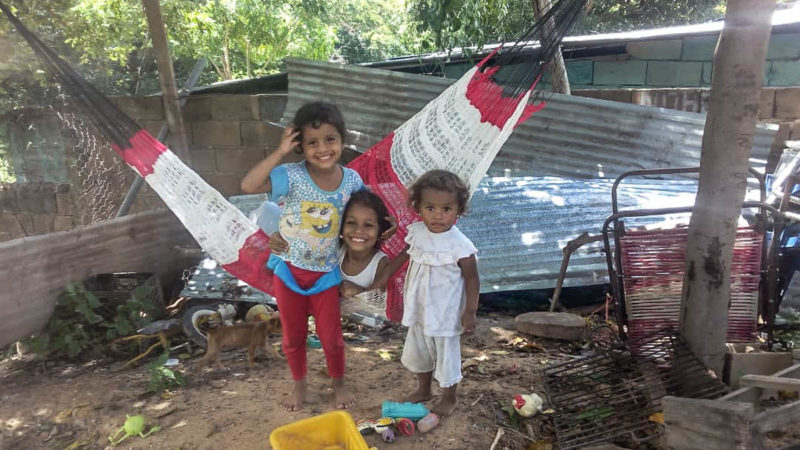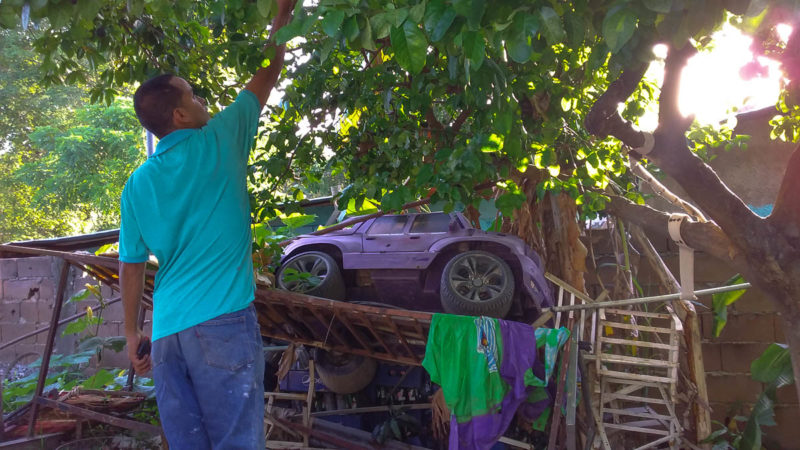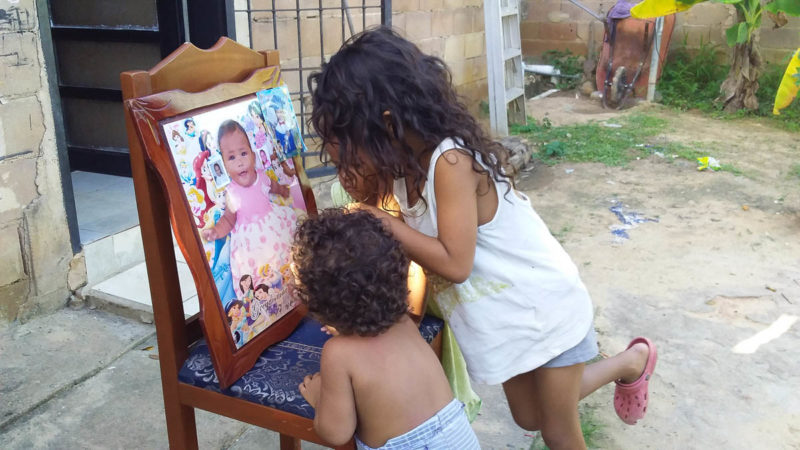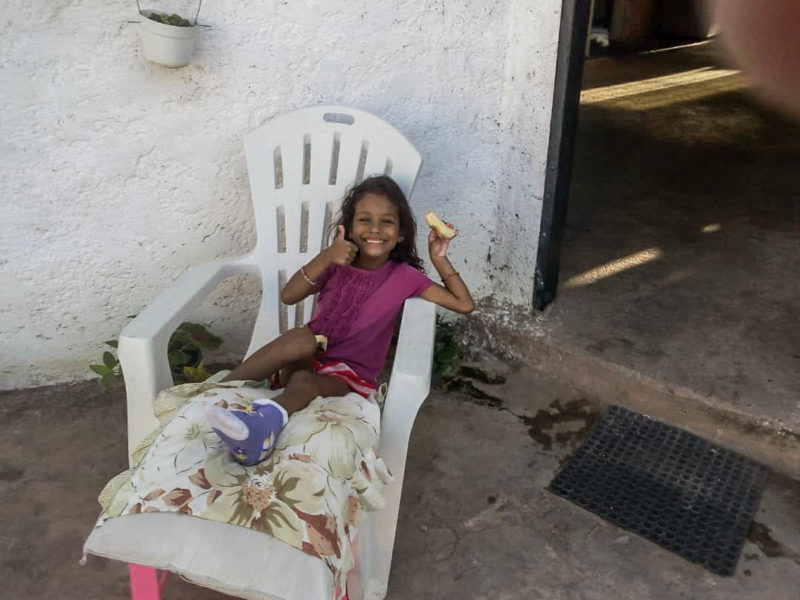Chronicles of Us: Let’s Take Our Girl to Brazil
When she was six years old, Dioselyn was diagnosed with osteosarcoma on her right foot. There was no chemotherapy in all of Guayana, so her only hope was to cross the Southern border to try to save her life.


Photos by author
It isn’t quiet in this little house at Ciudad Bolívar. Once you go in, you can hear cartoons on TV and the voices of three young girls. If they weren’t laughing, Carlos and Ediana, their parents, wouldn’t even dare to laugh themselves. They’d break down, as they’ve wished to do lately. Because they know that the choir of laughter is—and always will be—incomplete.
They no longer have Dioselyn’s overflowing joy.
The Diagnosis
They remember all they went through while trying to save her.
Playing with a battery toy car that she shared with her three younger sisters, Dioselyn, six years old at the time, fell and hit the heel of her right foot in April 2018. She said it hurt, but kept on playing. Ediana wasn’t concerned when, after a while, the little girl insisted that it was hurting a lot. She thought that by morning it’d be better.
But the foot didn’t stop hurting and in June, almost two months after the fall, it only got worse: the little girl couldn’t put her foot on the floor to walk. Ediana and Carlos took her to the emergency room at Doctor Héctor Nouel Joubert Hospital, in Ciudad Bolívar. They examined her and told them she had a fractured heel.

Ten days later, the biopsy results came in and as soon as Ediana saw them, she left running. The girl had osteosarcoma, a type of bone cancer that causes a lot of pain and swelling.
They immobilized her foot and went back home.
They thought the recovery would be quick and that the issue wouldn’t go further but, again, they were mistaken. After a few days, the girl’s foot began to swell. She’d cry, saying it hurt a lot. Dioselyn, who would normally spend her days laughing, dancing and running around, seemed to have shut off: she was quiet and wouldn’t get up from her hammock. She spent hours drawing her family, in silence.
Three weeks later, the foot was still swollen. Ediana thought that the splint wasn’t working and decided to take it off herself. Her grandmother suggested that they should go back to the doctor, and not waste more time waiting for things to improve.
Since she couldn’t walk, they took her in arms to the Hospital Universitario in Ciudad Bolívar, where traumatologists evaluated her. X-rays showed that none of her bones were broken. One of the specialists suspected what was going on and called an oncologist who, after looking at the x-rays and examining Dioselyn, said:
“We need to do a biopsy. It’s definitely not a fracture. I don’t want to get ahead of myself, but that looks like a tumor.”
Ten days later, the biopsy results came in and as soon as Ediana saw them, she left running. The girl had osteosarcoma, a type of bone cancer that causes a lot of pain and swelling.
The woman ran, nonstop, all four kilometers to her home.
No Chemo
Cancer. The word bounced around her head. No one in her family had ever gotten it. So far, it had been a disease people get in the movies.
A few days later, the girl was hospitalized to have more tests done. Doctors told them that the disease was well on its way; osteosarcomas are very aggressive and things needed to be radical. The right foot had to be amputated.
Carlos and Ediana, however, refused. They held onto the hope for another solution. How could their daughter be incomplete? What did they mean that she wouldn’t run freely anymore? No, they wouldn’t allow it.

Playing with a battery toy car that she shared with her three younger sisters, Dioselyn, six years old at the time, fell and hit the heel of her right foot in April 2018. She said it hurt, but kept on playing.
Carlos, in one of those heated discussions, lost it and almost punched a doctor in the face.
“We won’t allow you to take a hair from her!” yelled Ediana.
Doctors then discharged Dioselyn and agreed on chemotherapy to stop the growth of new cancer cells, eliminating the ones already existing. It was a less severe therapy, sure, but it was also much slower. They prescribed a cocktail of anticancer medication made up of methotrexate, ifosfamide, mesna and doxorubicin.
The treatment began at the Oncológico Virgen del Valle, a nearby medical facility, but they hadn’t had a pediatric specialist for over a year and they had no chemotherapy available.
Carlos and Ediana drove for five hours, with Dioselyn, all the way to Barcelona, in neighboring Anzoátegui State. They took her to the Hospital Universitario Luis Razetti, because they allegedly had pediatric oncologists there.
While that was true, they didn’t have chemotherapy either. The doctors suggested looking for it on the black market, like many patients and families do. For them, who only rely on the minimum wage earned by Carlos with his job at the governor’s office in Bolívar, that wasn’t possible: the drugs are expensive and paid in U.S. dollars.
They returned to Ciudad Bolívar.
The Trip
Time went by and the pain was getting worse. They gave Dioselyn high doses of painkillers, but that barely helped.
The doctors from the Oncológico Virgen del Valle invited her to an activity from a foundation, where the girl spent time with other children with cancer. They talked a lot: they told her how their hair had fallen out, why they used a mask, and they explained that chemotherapy didn’t hurt, but it made you throw up, feel nauseous and get diarrhea. They also played together.
Some of the parents told Carlos and Ediana that, while looking for a solution to chemotherapy shortages, they had gone to Boa Vista, Brazil, 935 kilometers away from Ciudad Bolívar, because treatment over there is free.

Some of the parents told Carlos and Ediana that, while looking for a solution to chemotherapy shortages, they had gone to Boa Vista, Brazil, 935 kilometers away from Ciudad Bolívar, because treatment over there is free.
Since Dioselyn’s parents didn’t have the money for the trip, they reached out to others; in the morning of October 10th, 2018, Ediana and her brother-in-law began their trip to Brazil. Carlos stayed behind to look after the other girls. Normally, the trip takes a day, but it took them almost three, because Pemones in the area were protesting and closed down the Troncal 10, the long stretch connecting Venezuela to Brazil.
They finally arrived on October 12th at night, going straight to the hospital in Boa Vista, where they admitted Dioselyn right away. They were given dinner and a group of specialists started to evaluate her. This hospital wasn’t equipped for cancer treatment, but once they evaluated her case there, she’d be included in the Brazilian healthcare system.
Days went by very slowly. Ediana and her brother-in-law would call home. Dioselyn would draw. Doctors would perform tests. They were there on October 16th for the girl’s birthday, one of the few days where she didn’t smile, even though Ediana braided her hair and sang happy birthday along with hospital staff.
“Honey, don’t worry, we’ll soon go back to Ciudad Bolívar to celebrate with your sisters and your dad. We’ll also go to the beach.”
“Mom, don’t remind me of my sisters because I get sad.”
A few days later they found out that the disease was gaining ground: the tests revealed that Dioselyn had tumors in both her lungs and bladder. Since they couldn’t treat her there, on November 6th (with a breathing tube and a catheter) she was airlifted to the Love Hospital, in São Paulo, over 4,500 kilometers away.
The specialists told Ediana that, because of the progression of the disease, they couldn’t give her daughter the chemotherapy. She was admitted into the Intensive Care Unit. While she was awake, she complained a lot about the pain.
On November 14th a hospital psychologist approached Ediana: she told her that Dioselyn would be hooked to a breathing machine until her organs gave out.
It could take weeks.
Or days.
Or maybe hours.
Ediana began praying. She called her husband in Venezuela to tell him the news. Then she went into the ICU and spent four hours with her daughter. She asked for forgiveness, telling her how much she loved her. Telling her not to be afraid.
She was still at it when her daughter’s heartbeat became weaker and weaker on the little screen.
She called the doctors. There was nothing they could do.
“My daughter needed to hear everything I said, to go in peace. She knew how much we loved her.”
The healthcare system moved the body back to Boa Vista by plane. From Venezuela, Carlos made the arrangements and gathered the resources for repatriation. It took four days for her to arrive by land. It had been a month and a half since he said goodbye to her.
Today, the other three girls are still laughing. The cartoon show isn’t over.
Sometimes they see her picture and ask where their sister is.

“Honey, don’t worry, we’ll soon go back to Ciudad Bolívar to celebrate with your sisters and your dad. We’ll also go to the beach.”
This piece, originally published in Spanish in La Vida de Nos, was produced in the workshop La Vida de Nos Itinerante, where many authors all around Venezuela learn how to collect and write real-life stories. Translated by Inés Urbaneja. Edited by The Caracas Chronicles Team.
Caracas Chronicles is 100% reader-supported.
We’ve been able to hang on for 22 years in one of the craziest media landscapes in the world. We’ve seen different media outlets in Venezuela (and abroad) closing shop, something we’re looking to avoid at all costs. Your collaboration goes a long way in helping us weather the storm.
Donate




